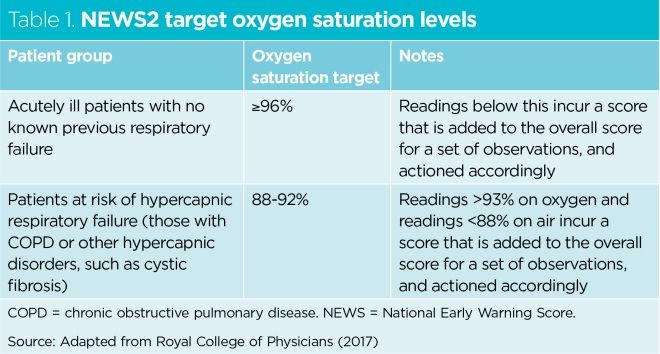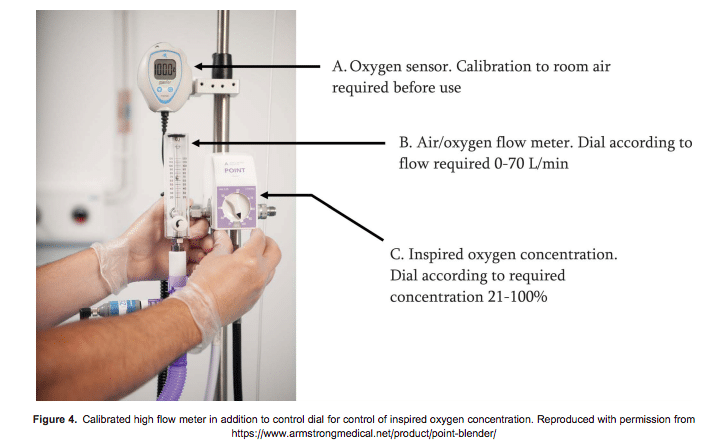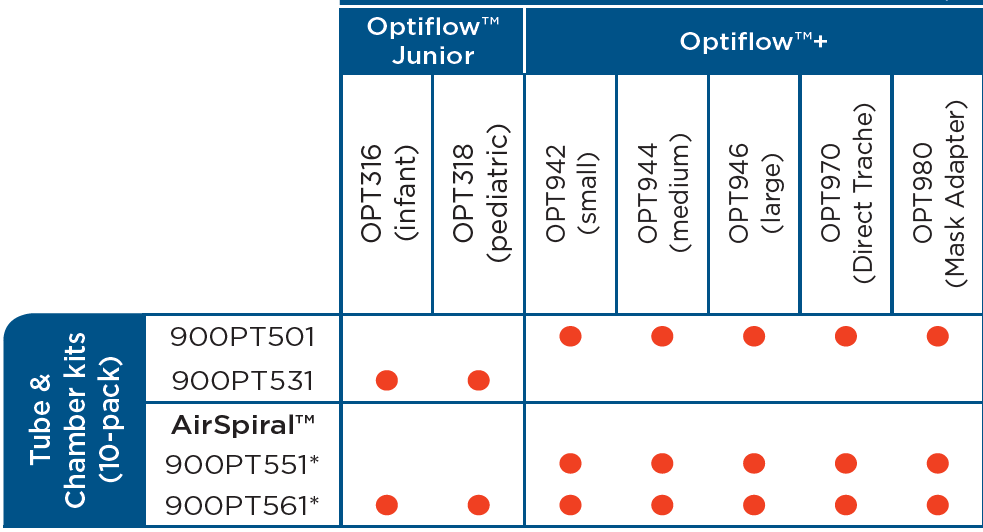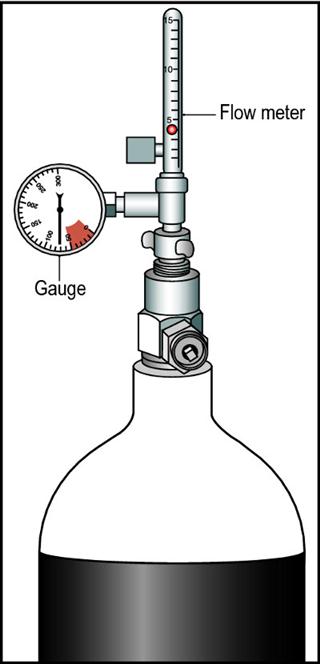oxygen delivery devices and flow rates uk
Only goes up to 60 FIo2 so not for patients who have significantly high oxygen demands bulky. 200969111 Bailey P Thomsen GE Spuhler VJ et alCrit Care MedJan2007351139145.

Ensuring The Safe Use Of Emergency Oxygen Therapy In Acutely Ill Patients Nursing Times
The humidifier should always be placed at a level below the patients head.

. It is used for the application of heated and humidified blended air and oxygen at high flow rates typically set between 30 lmin and 50 lmin. The percentage of oxygen inspired depends on the flow rate and the delivery device. Flow rates of 2-4 litresmin are normally used.
Oxygen delivery by TTOC bypasses the anatomical dead space in the upper airways and mouth allowing oxygen to pass directly into the trachea. How much FiO2 you receive from your oxygen concentrator depends on your flow rate. Oxygen delivery typical flow devices single use rate range oxygen sources that can be used with each device.
Oxygen delivery devices and flow rates should be adjusted to keep the oxygen saturation in the target range. 2 to 15 Lmin. So the maximum oxygen which can be delivered by nasal cannula is 44.
A 28 valve will have a smaller hole than a 40 valve and so on. Oxygen flow through a TTOC ranges between 05 and 4 Lmin 1. There are two important things to consider when delivering supplemental oxygen to your patient.
Lmin 1 Resultant oxygen concentration. Higher flows 4 Lmin make it uncomfortable for the patient. Terms in this set 8 1-6 Lmin.
Discuss the different options with your respiratory specialist. What is a nasal cannula. Ensure delivery device is connected via tubing to oxygen supply and turned on to the appropriate flow rate if cylinder check fill level of cylinder and be aware of duration time.
Venturi valves deliver the following fixed. You can breathe in the oxygen from its container either through nasal cannula or a face mask. A nasal cannula can be used to deliver up to six litres of oxygen a minute comfortably.
It varies from 0 15L per minute. The tip of nasal cannula should lie in nasopharynx. This video - produced by students at Oxford University Medical School in conjunction with the faculty - demonstrates how to deliver oxygen therapy through va.
Prompt clinical assessment is required if oxygen therapy needs to be initiated or increased due to a falling saturation level. Adapters deliver set amounts of FiO2 at 24 to 60. Delivers unpredictable oxygen concentrations between 22-35 that vary with flow rate and respiratory pattern and rate.
Hudson mask Teleflex Medical 56. Low flow device Most common device used for mild hypoxia Can be set between 1 and 6 LPM 24 to 40 FiO2 FiO2 increases approximately 4 with each liter of O2 KorupoluR GJ Needham DMContemporary CriticalCare. Oxygen therapy can be delivered using a low flow or high flow system.
It is NOT the Lmin stated on the venturi that is delivered to the patient. Can delivery precise and dependable FiO2. The type of humidification device selected will depend on the oxygen delivery system in use and the patients requirements.
26Lmin gives approx 2450 FIO2 FIO2 depends on oxygen flow and paents minute. 2 flow rates of less than 2 L O 2 lmin or if minute ventilation is very high 4 Lmin of oxygen flow delivers an FiO 2 of about 03504 providing there is a normal respiratory pattern Flow rates greater than 8Lmin do not increase FiO 2. The flow rate is how many liters of oxygen per minute your device delivers.
The actual amount of oxygen the patient receives will depend on the rate and depth of respiration. When tightly fitted they can provide approximately 100 oxygen. They include Nasal cannulae.
High-flow oxygen therapy for spontaneously breathing patients. If you need a higher flow rate of oxygen its likely you will need a face mask. Flow rate and exact FiO2 on colored mask piece do NOT use with humidification.
Hudson Nonrebreather Teleflex Medical 1012 80100. Deliver oxygen to paents. Venturi mask flow rate and FiO2 ranges.
There are two important things to consider when delivering supplemental oxygen to your patient. Simple Oxygen Face mask. Can be used in patients with stable Type II respiratory failure.
High-flow oxygen therapy is applied with a special binasal high-flow nasal cannula HFNC and a heated inspiratory breathing circuit. They have valves which deliver a fixed concentration of oxygen eg. Low flow O2 delivery device 05-6 Lmin.
Oxygen saturation and delivery system including flow rate should be recorded on the patients monitoring chart. For example patients commonly use a flow rate of 2 liters per minute but the flow rate varies by each patients needs. Where there is a risk of carbon dioxide retention target 88-92 start oxygen therapy using a 28 Venturi device and mask.
A flow rate of 2 liters per minute increases the FiO2 from 21 percent room air to 28. Designed to entrain a set amount of O2 and air which combine to produce a set flow of O2 the stated on the venturi. These devices deliver a variable inspired oxygen concentration to the patient which depends on the PIFR.
Nasal Cannulae Recommended in the Guideline as suitable for most paBents with both type I and II respiratory failure. Delivery devices work with different flow rates. FiO2 is defined as the percentage or concentration of oxygen that a person inhales the fraction of inspired oxygen.
Each valve is colour coded Figure 3 although newer valves can be set at the desired FiO2 in a single unit. The oxygen flow rate and the FiO2. Depending on a patients inspiratory effort tidal volume speed of inspiration and respiratory rate the PIFR can often exceed the flow rate at which oxygen or an oxygenair mixture is supplied by the device meaning that at the time of PIFR.
All high flow systems require humidification. Flow rate 1-4Lmin 4L will dry the nose 2L is more comfortable. These are another type of Oxygen Delivery Devices can deliver up to 80 of oxygen.
Oxygen delivery devices and flow rates uk. Oxygen delivery device Oxygen flow rate. High capacity oxygen delivery device High capacity oxygen delivery devices capacity 250-1500 ml With these devices O 2 flows directly into the reservoir bag which fills whenever the patients inspiratory flow rate is lower than the flow rate of delivered O 2The patient thus inhales O 2 preferentially from the reservoir bag and ambient air is not entrained avoiding dilution of.
Nasal cannulae Teleflex Medica 1. The oxygen flow rate is the number that we dial up on the oxygen flow metre usually between 1-15Lmin. The flow rate can be set on the wall tap.
Venturi masks are high flow delivery devices.
Mitchell Home Medical Referral Help

Oxygen Delivery Devices Chapter 10 Diagram Quizlet

Types And Characteristics Of Oxygen Delivery Devices Download Table

Oxygen Therapy And Delivery How To Prescribe Oxygen Youtube

Preoxygenation Deoxygenation And Reoxygenation During Intubation

Oxygen Delivery Devices Ati Flashcards Quizlet

Types And Characteristics Of Oxygen Delivery Devices Download Table
Clinical Guidelines Nursing Oxygen Delivery

Oxygen Delivery In The Home Setting

Oxymask Versus Traditional Oxygen Devices Download Table
High Flow Nasal Cannula Oxygen Therapy Hfnct For Infants And Children Not For Use In Nicu

Clinical Guidelines Nursing Oxygen Delivery

High Flow Oxygen In Anaesthesia And Critical Care Wfsa Resources

Covid 19 And O2 Therapy Initial Prehospital Approach In Mild Symptomatic Patients Medest



